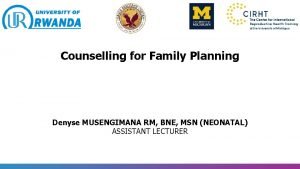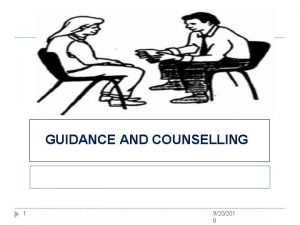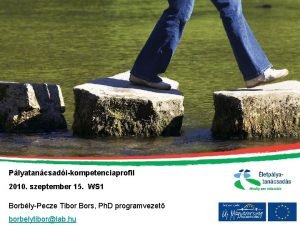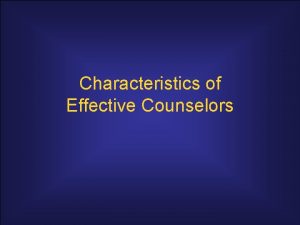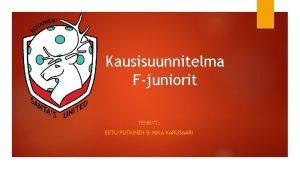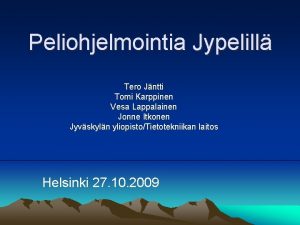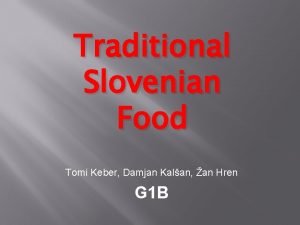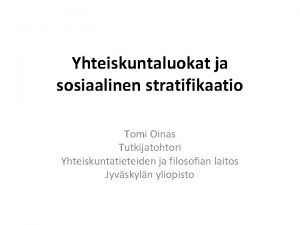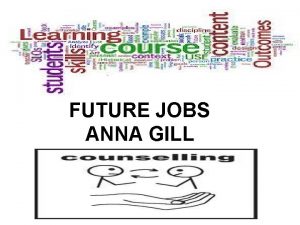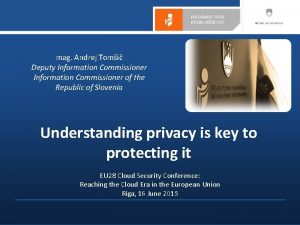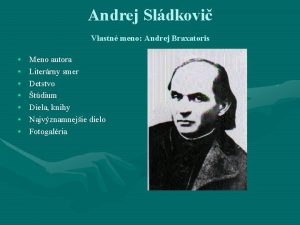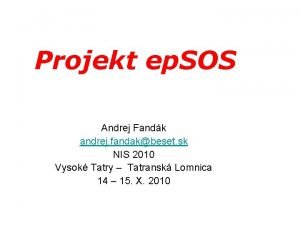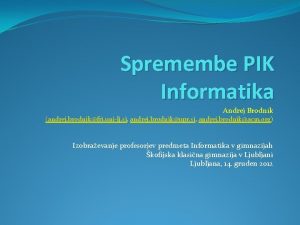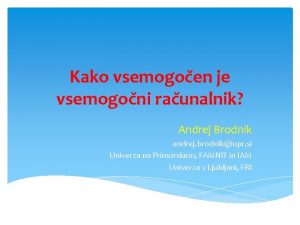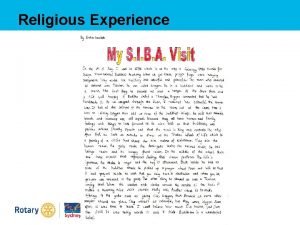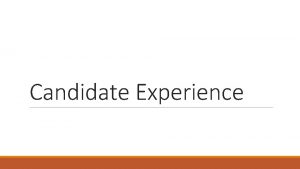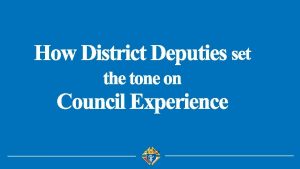Andrej Tomi Counsellor andrej tomsicgov si Experience of












- Slides: 12

Andrej Tomšič Counsellor andrej. tomsic@gov. si Experience of Slovenia in Providing and Mesuring Public Internet Access Global Workshop on Community Access Indicators Mexico City, 18 th November 2004

2 European Union Member as of 1 st May 2004 Positioning of Slovenia 69% of GDP per capita in PPS (EU-15=100) GDP per capita EUR 12, 273 (2003) Consumer Prices December 2003=100 Aug/04: 103, 8 Population: 1, 96 mio Capital: Ljubljana (265, 881 inhabitants) Area: 20, 273 km 2 http: //www. uvi. si/eng/slovenia/publications/facts/general/ http: //www. gov. si/mid

3 http: //www. gov. si/mid

4 SLOVENIA – GLOBAL RANKINGS • • ITU – ICT Accessibility: UNESCO – “Infostate”: UN – e. Government: WEF - Network Readiness Index (NRI) 21 st 24 th 29 th 30 th Source: National Statistics Office of the RS, Q 1 2004 The Internet is becoming a daily routine for majority of users. Population average 43% http: //www. gov. si/mid Overall internet usage among Slovene youth is most encouraging – 58% of children use the Internet.

5 Ministry of Information Society Established 16 th January 2001 • Action plans • e. EUROPE 2003+ • e. EUROPE 2005 • Strategic and Legal Framework Strategy of The Republic of Slovenia in Information Society Strategy of e-Business in local government Policy of the Government of the RS for the development, introduction and use of open-source software and solutions Acts: on Electronic Communications (ZEKom) on Electronic commerce and electronic signature (ZEPEP-1) + decree on Author rights (ZASP) on Protection of personal data (ZVOP) on Consumer rights (ZVpot) on Access to public sector information (ZDIJZ) + decree on Integration of public legal registries (ZPJE) http: //www. gov. si/mid

6 portal e-točk eschools 26 elibraries 117 info terminals 34 other e-points 122 MM centres 7 WLAN 65 TOTAL 370+ 50 km The E-Points portal http: //www. gov. si/mid http: //e-tocke. gov. si

7 Ministry of Information Society Ministry of Education, Science and Sport The E-school project Digital Communication Centre and Education Centre Aims: • ensuring free access to ICT for everybody; • empowering the people for successful inclusion in the information society; • improving the rate of digital literacy; • expanding the network of public internet access points; • bridging the digital divide. • fair geographical coverage. The E-school: • primary and secondary schools opened to broad public outside teaching hours (15 -19 h); • ISDN/ADSL connection, avg. 10 PCs, software, printer, scanner. . . financed by MIS /Mo. ESS • mentors providing help; • courses, lectures. . • usage is free! E-schools – the results • 2002: 10 locations -> 38. 425 visitors • 2003: 22 locations -> 83. 758 visitors • 2004: 5 more locations • monthly average: 7. 000 – 8. 000 • better ICT equipped schools • e-skills E-school = PIAC with added value! http: //www. gov. si/mid

8 2001/02 2002/03 DCC EDUCATION CENTRE 2003/04 Number of e-schools: (October 2004) E-school visitors: (2003) http: //www. gov. si/mid 26 83. 758

9 Lessons Learned • • ensuring equitable and free access is very important at early stages of IS development • access to infrastructure (electrical, telecom, cable etc. ) is fundamental • PIACs have a vital role (esp. in larger, less densly populated countries) • schools and libraries have excellent preconditions for becoming DCCs • connect the libraries and “open up” the schools! Internet users: at home: 70% at workplace: 54% at school: 22% PIACs: 12% (e. g. : BG – 46%) ------------only at PIACs: 1% having reached a certain stage of development: • act towards bridging the digital divide – the three most endangered groups are: • poorly educated • low income • elderly people • home acccess becomes prevailing, PIACs less visited • plain public internet points loose on importance (so do the measurements – e. g. e. EUROPE 2005) • added value access centres gain on importance (providing tools AND skills to use them) • collecting data on usage, skills, impact becomes focal http: //www. gov. si/mid

10 PIACs – Open Issues • Governmental or private PIAC? -------------------------- • too many possibilities! DCCs E-LIBRARIES • e. g gov bought equipment, privately owned location • associations, donations. . . etc? • Three-tier PIAC topolgy proposed: • pure governmental (infoterminals. . . ) • PPP • fully private (cyber-cafés) library of an education centre meeting DCC minimum requirements • Perhaps all in all not that important EDUCATION CENTRES Brainstorming based on different national/regional experiences needed http: //www. gov. si/mid

11 Benchmarking Experience • well-defined PIAC typology is needed • when is a PIAC governmental/private? -> not that much important • Regional Workshop 2003 -> usage indicators have been well thought of - > less adequate for small countries (short distances) • identify areas in need of a PIAC (esp. if no private initatives exist) • education centres can serve as DCCs • surveys from private agencies tend to be hgood but grossly uncomparable • National Statistics Offices offer reliability and comparability but adapt slowly to IT-driven changes • later on: should we count WLANs as well? • stable and precise definitions are crucial for international comparisons • main lines per 100 inh. mobile subscribers per 100 inh. internet users per 100 inh. etc. • once DCCs are established -> collect data on: • reach of a DCC (potential, actual) • PCs/PIAC • numbers of visitors • age and gender distribution • use of ICT (word processors, spreadsheets, surfing, fun. . . ) http: //www. gov. si/mid

12 Thank you for your kind attention! andrej. tomsic@gov. si Ministry of Information Society http: //mid. gov. si/ DG Information Society http: //europa. eu. int/information_society/index_en. htm Research on Internet in Slovenia (RIS) http: //www. sisplet. org/ris/index. php SIBIS http: //www. empirica. biz/sibis/ e. EUROPE+ 2003 benchmarking European Ministerial Conference on IS (I) http: //emcis. gov. si/ European Ministerial Conference on IS (II) http: //www. emcis 2004. hu/dokk/main/emc/venue e. EUROPE 2002, 2005 benchmarking e. EUROPE 2005 http: //europa. eu. int/information_society/eeurope/2005/index_en. htm Europe's Information Society http: //europa. eu. int/information_society/index_en. htm http: //www. gov. si/mid
 Family planning counsellor
Family planning counsellor Merits and demerits of directive counselling
Merits and demerits of directive counselling Counsellor jelentése
Counsellor jelentése Characteristics of effective helpers
Characteristics of effective helpers Orebro counsellor
Orebro counsellor Imprint definition psychology
Imprint definition psychology Early experience vs later experience debate
Early experience vs later experience debate Direct experience vs indirect experience
Direct experience vs indirect experience Lynne jones jennings
Lynne jones jennings Tomi putkinen
Tomi putkinen Tankkipeli
Tankkipeli Tomi keber
Tomi keber Tomi oinas
Tomi oinas
